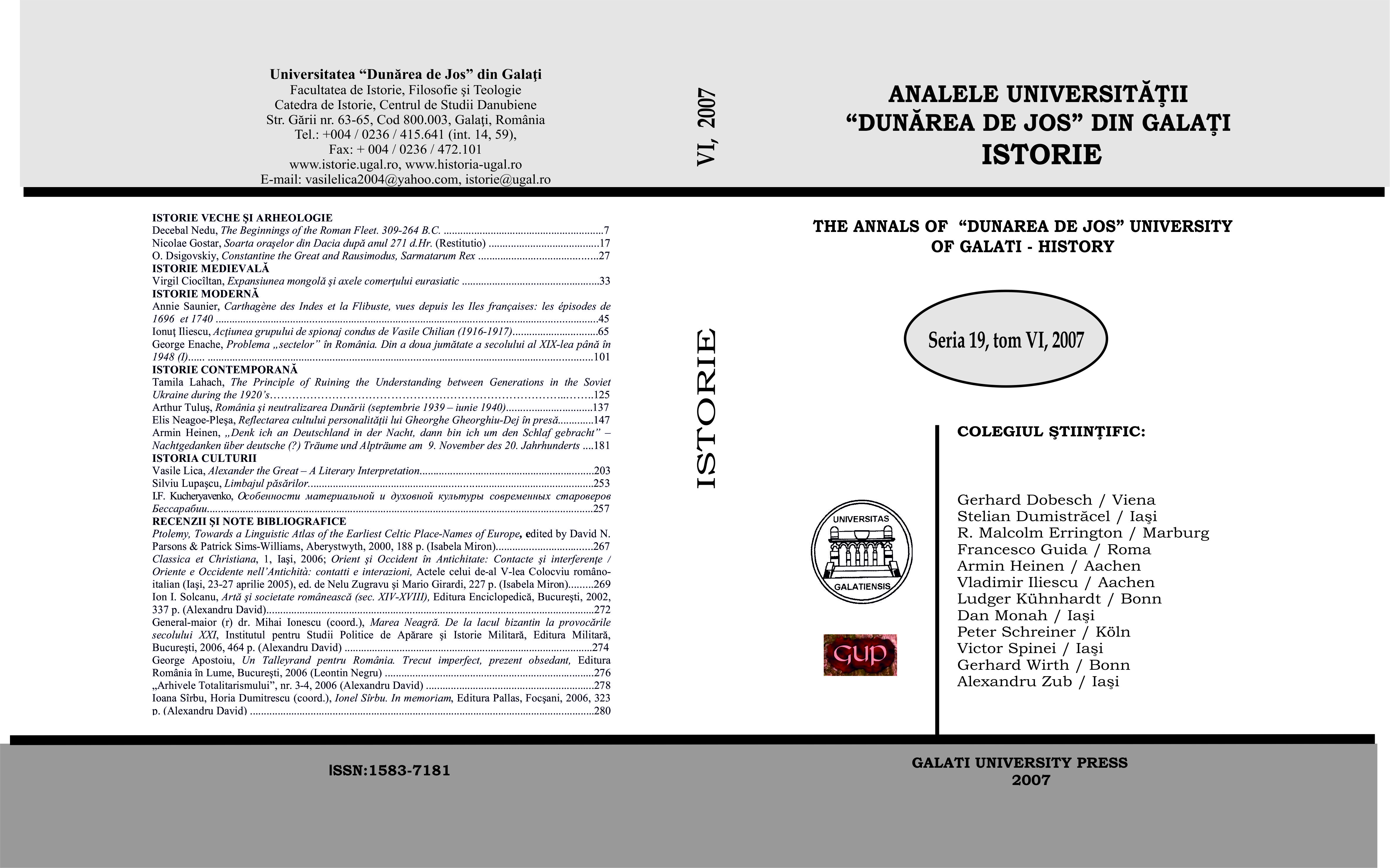Acţiunea grupului de spionaj condus de Vasile Chilian (1916-1917)
The Actions of the Espionage Group Led by Vasile Chilian (1916-1917)
Author(s): Ionut IliescuSubject(s): History
Published by: Galaţi University Press
Keywords: espionage; World War I; Vasile Chilian; Romania
Summary/Abstract: In the year 1916, behind the Romanian-German battle-line, in the area under the jurisdiction of the German Army, there were both thousands of soldiers who wanted to pass beyond the battle-line towards the territory freed by the Romanian Army and lots of Romanians who, not being able to bear the cruel treatment applied by the Germans, wanted to arrive to the free Romanian area. Because the Vrâncean villages west of Putna county were under German jurisdiction, a group of Romanian patriots – Vasile Chilian from Vidra, helped by Ştefanache Săcălus - the Mayor of Paulesti village, Toma Ion Cotea from Căliman-Vidra and Dumitru (Dumitrache) Pantazică from Tichiriş – co-coordinated large spying operations which in a short period of time became a really large spying network, made up of tens of persons and acting in the mountainous area of Buzău and Putna counties. These operations had a double goal: to send a large amount of information related to the enemy, using all possible means: position, the troops’ structure, material endowment, offensive or defensive aims etc.; to help Romanian soldiers from the area under the jurisdiction of the German Army or those who escaped from the prison camps to cross the battle line.Chilian, Pantazică and Săcăluş, playing the collaborationist role, could act both much more easily and efficiently. They received the necessary approval for a water mill on the Putna river to mill wheat and make flour for the German troops and thus they could hide in the mill attic those people who passed towards the free area, but only those secretly chosen by Ştefanache Săcăluş. In addition, Pantazică and Săcăluş offered their own houses to the Germans in order to install their Head Quarters and thus they were able to offer to the Romanians large amounts of information referring to the enemy. They used various ways of sending the information: through Romanian soldiers who got across the front line, through people who knew the mountain paths very well, using message bottles carried by the water of Putna and through the so-called cerga code.An impressive number of Romanian soldiers, over 2.000, followed the instructions offered by Chilian’s group and crossed the line through Putna river and joined the Romanian army in the period December 1916 - May 1017.The Vrâncean patriots were captured and sent in the penitentiary of Focşani, a town under German jurisdiction, after the failed attempt of passing a group of soldiers across the battle-line. The investigation and trial – developed in two stages- lasted 80 days all together, everything reaching a climax when the sentence of death was given by Germans to Vasile Chilian, Ştefanache Săcăluş, Toma Ion Cotea, Dumitru Pantazică and the sergent Vasile Gălăţeanu from Piatra Neamt. The execution took place on the 17th August 1917 when the Vrâncean heroes died dignified, with their free conscience of doing their duty for their country. They were buried in the yard of 10 Regiment Dorobanţi-Putna.Fortunately, both the Putna’s population and the main authorities never forgot their supreme sacrifice, showing the eternal gratitude owed to them. Thus from 1923 the families of the four heroes received financial support from the state; in 1936 there was built a monument in Vidra which keep in the stone their names eternally; in 1940 the four heroes’ bodies were taken with all honours to Focşani Mausoleum; and the Cultural Institutions from the old Vrancea Country, the cultural societies from this area periodically bring to life their patriotism, heroism and courage proved by the Vranceans and implicitly by Stefanache Sacalus from Paulesti.The history and literature give their homage on the patriotism sanctuary for the four Vranceans, dedicating to them lots of books and a series of studies and articles.
Journal: Analele Universităţii Dunărea de Jos din Galaţi. Seria Istorie
- Issue Year: 2007
- Issue No: 06
- Page Range: 65-100
- Page Count: 36
- Language: Romanian

